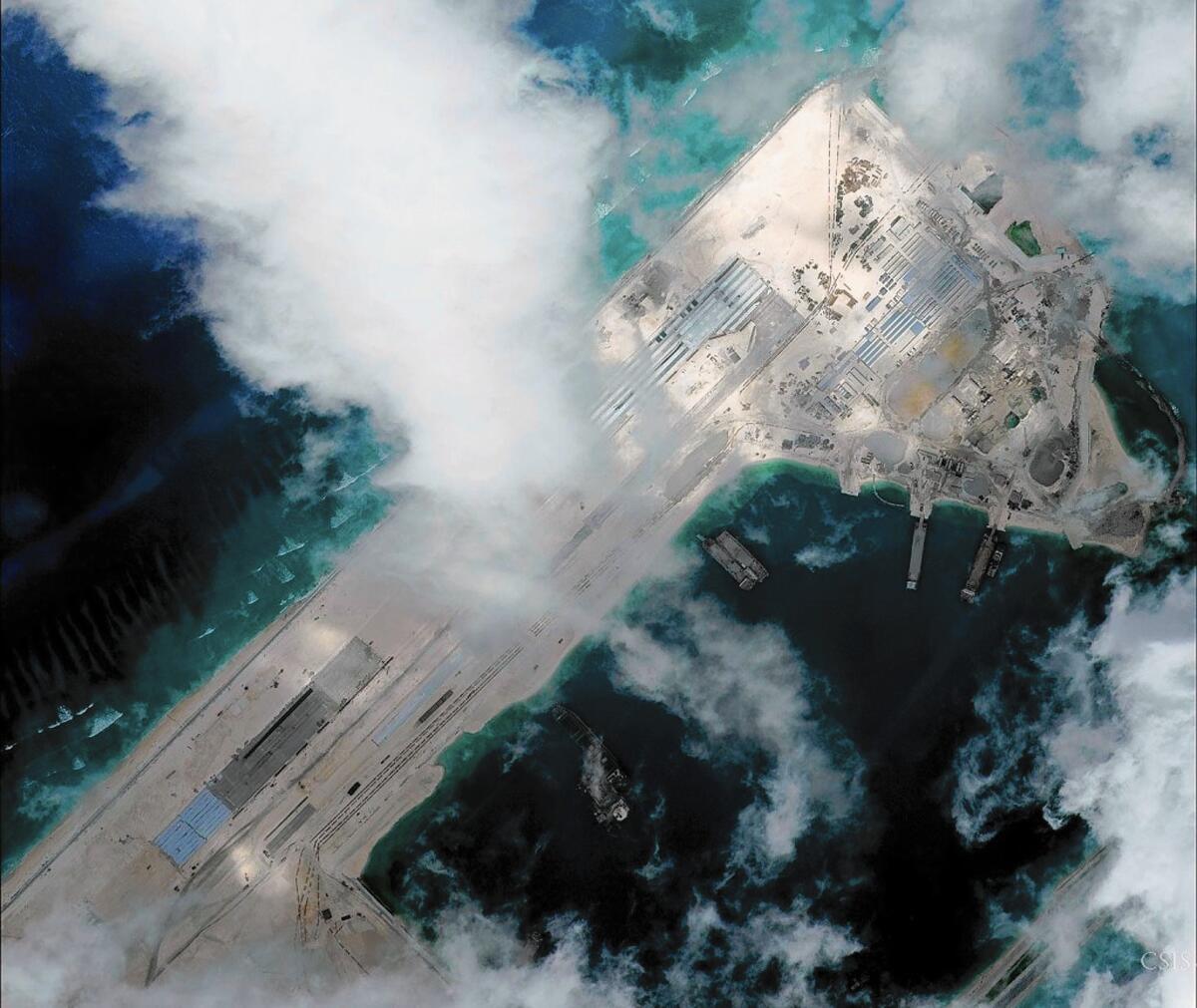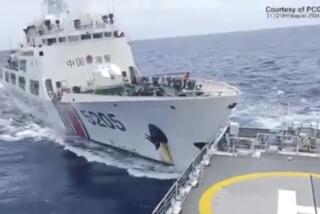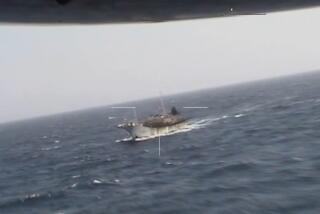U.S. publicly challenges China’s moves in disputed islands

Reporting from Washington — The U.S. military has begun to carefully but publicly challenge Chinese island-building on disputed reefs and shoals in the South China Sea, creating fresh tension in a potential global tinderbox as both countries shift forces into the area.
In the latest incident, a Chinese military dispatcher demanded repeatedly that a U.S. Navy P-8A Poseidon surveillance aircraft leave as it flew near Fiery Cross Reef in the Spratly Islands, where China has dredged hundreds of yards of coral and sand and built an airstrip on what it claims is sovereign territory.
“Foreign military aircraft, this is Chinese navy. You are approaching our military alert zone. Leave immediately,” the Chinese dispatcher said in a radio transmission, the Navy recounted Thursday.
When the U.S. crew responded that it was flying in international airspace, the Chinese dispatcher answered, “This is the Chinese navy.... You go!” The U.S. plane, which was operating from an air base in the Philippines, received eight warnings from the Chinese during the mission.
Verbal sparring is common between the two militaries, but the Pentagon decision to release two videos and audio recordings from the dust-up a day earlier — less than a week after it disclosed that a U.S. warship also had sailed through the Spratlys — shows a new willingness to publicly confront Beijing for expanding construction projects in waters believed to be rich in oil and gas, and close to vital shipping lanes.
U.S. officials said they are determined to preserve freedom of international navigation and airspace, but are not seeking to provoke a confrontation with China.
The jockeying comes as Defense Secretary Ashton Carter heads to Asia next week on a trip intended to shore up security alliances in a region increasingly nervous about China’s policies. He will visit Singapore, Vietnam and India.
Regional tension has grown since President Obama announced a so-called U.S. strategic pivot to Asia four years ago, in part to keep an eye on a fast-rising China. The administration has shifted ships and troops to the Western Pacific and expanded military ties with several countries worried about China’s growing clout, including Japan, the Philippines, Australia and, to a lesser extent, Vietnam.
The renewed American focus on the region appears to have led to unintended consequences, however. Beijing has become more aggressive in asserting its maritime and territorial claims in the South China and East China seas.
Some senior Chinese officials fear that the U.S. military “has effectively ‘boxed in’ China,” Jeff Smith, director of Asia security programs at the American Foreign Policy Council, a Philadelphia think tank, wrote in this month’s Foreign Affairs magazine.
The Chinese are “eager to punish neighbors such as Japan, Vietnam and the Philippines — and even India — who they believe capitalized on a period of relative Chinese weakness to assume control of disputed islands in the South and East China Seas,” he said.
For now, U.S. officials believe they can pressure China to scale back its island-building by galvanizing other Asian governments against it. In recent months, the U.S. has encouraged Japan to begin naval patrols in the South China Sea, where it doesn’t normally sail, and provided ships and other equipment to the Philippine and Vietnamese coast guards.
“As China seeks to make sovereign land out of sandcastles and redraw maritime boundaries, it is eroding regional trust, undermining investor confidence and challenging the energy security upon which all of us depend,” Deputy Secretary of State Antony Blinken said in a speech Wednesday in Jakarta, Indonesia.
The U.S. surveillance flight came less than a week after the Fort Worth, a Navy littoral combat ship designed for near-shore operations, passed close to the Spratly Islands, where the Chinese are dredging sand and building up five reefs.
Pentagon officials said the patrol was meant to show that Washington does not accept China’s claims that seas surrounding the disputed reefs constitute Chinese territorial waters. Chinese navy ships tailed the U.S. vessel during the patrol.
“What you’re seeing by the U.S. is a calculated, transparent effort to reveal the situation in all of its details and potential dangers,” said Mira Rapp Hooper, an expert in maritime disputes at the Center for Strategic and International Studies, a Washington think tank. But when military forces operate in such proximity, she warned, “there is always the danger of inadvertent or accidental escalation.”
In 2013, China announced a so-called air defense identification zone in the East China Sea, requiring aircraft in the area to identify themselves and implying that those in violation could be shot down. The U.S. soon sent two B-52 bombers through the zone without giving notice, a move that U.S. officials believe led Beijing to end its demands.
Pentagon officials worry that Beijing may next try to declare an air defense identification zone in the South China Sea.
The Poseidon surveillance plane flew from Clark Air Base in the Philippines. Once the largest U.S. air base in the Pacific, it was turned over to the Philippine government in 1991 after the eruption of the nearby Pinatubo volcano. The U.S. has been flying surveillance missions in the South China Sea from the Philippines since January.
Videos released by the Navy on Thursday show the P-8A flying near Fiery Cross Reef and several of the other coral outcroppings where U.S. officials say the Chinese have created 2,000 acres of land since last year.
An unidentified Navy lieutenant can be seen pointing out features on Fiery Cross Reef, including a partially finished airfield, a dredger vacuuming up sand and several plants for producing concrete.
“Currently what we’re looking at is some construction on a landing strip,” he says, pointing at one of the plane’s high-resolution video screens. “You see here the landing strip and on the backside the taxiway that they’re building. They’ve built hundreds of meters in the past couple months.”
As the plane’s cameras scan the sandy shoal, surrounded by aqua waters, he says, “Once you pan to the east, there’s a dredger active that will take land from the ocean and pile it up to build more land, which gives them more space.”
At one point, the video shows a radioman writing down a message from the Chinese dispatcher and a reply from the P-8: “I am a U.S. military aircraft conducting lawful activities,” it reads.
In Beijing on Thursday, a Foreign Ministry spokesman reiterated China’s claims of sovereignty in the Spratly archipelago.
Hong Lei said that he had no information about the warnings to the U.S. surveillance plane, but that China was “entitled to the surveillance over related airspace and sea areas so as to maintain national security and avoid any maritime accidents.”
“We hope relevant countries respect China’s sovereignty over the South China Sea, abandon actions that may intensify controversies and play a constructive role for regional peace and stability,” Hong said at a daily news briefing, according to the Associated Press.
ALSO:
Chinese investments in U.S. businesses are accelerating
Pentagon official lists militants, Russia and China as threats to U.S.
Allegations of S. Korean atrocities arising 40 years after Vietnam War
More to Read
Sign up for Essential California
The most important California stories and recommendations in your inbox every morning.
You may occasionally receive promotional content from the Los Angeles Times.










